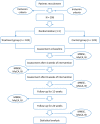Effects of different acupuncture treatment methods on post-stroke cognitive impairment: study protocol for a multicenter randomized controlled trial
- PMID: 33407773
- PMCID: PMC7789521
- DOI: 10.1186/s13063-020-04959-y
Effects of different acupuncture treatment methods on post-stroke cognitive impairment: study protocol for a multicenter randomized controlled trial
Abstract
Background: Cognitive impairment is a common dysfunction after stroke that seriously affects the overall recovery of patients. Cognitive rehabilitation training is currently the main treatment to improve cognitive function, but its curative effect is limited. Acupuncture is a core component of traditional Chinese medicine (TCM), and some previous clinical studies have shown that it might be effective in treating post-stroke cognitive impairment (PSCI), but further evidence from large-sample studies is needed. The overall objective of this trial is to obtain further data to develop an optimized acupuncture treatment for PSCI by comparing the effects of different acupuncture treatment methods on cognitive function in PSCI patients.
Methods/design: In this multicenter, prospective, randomized controlled trial, 206 eligible stroke inpatients who meet the trial criteria will be randomly assigned to 2 groups: an electroacupuncture (EA) plus needle retention (NR) group and an EA group. Both groups of patients will undergo the same routine cognitive rehabilitation treatments. All treatments will be given 5 times per week for 8 weeks. The primary outcomes will be assessed using the Mini-Mental State Examination (MMSE) and the Montreal Cognitive Assessment scale (MOCA). The secondary outcome will be measured by the Barthel Index (BI). All outcomes will be evaluated at baseline, week 4, week 8, and the third and sixth month after the end of treatment.
Discussion: Our aim is to evaluate the effects of two different acupuncture treatment methods for treating PSCI patients. This study is expected to provide data to be used in developing an optimized acupuncture treatment method for PSCI treatment.
Trial registration: Chinese Clinical Trial Registry ChiCTR1900027849. Registered on 30 November 2019, http://www.chictr.org.cn/showproj.aspx?proj=46316.
Keywords: Acupuncture; Clinical trial; Cognitive impairment; Stroke.
Conflict of interest statement
The authors declare that they have no competing interests.
Similar articles
-
Evaluation of the efficacy and safety of the use of acupuncture for the adjuvant treatment of patients with post-stroke cognitive impairment: protocol for a randomized controlled trial.Trials. 2020 Aug 28;21(1):753. doi: 10.1186/s13063-020-04656-w. Trials. 2020. PMID: 32859250 Free PMC article.
-
Effectiveness of Yijinjing on cognitive functions in post-stroke patients with mild cognitive impairment: study protocol for a randomized controlled trial.Trials. 2021 Apr 9;22(1):265. doi: 10.1186/s13063-021-05220-w. Trials. 2021. PMID: 33836807 Free PMC article.
-
Effect of acupuncture treatment on post-stroke cognitive impairment: A randomized controlled trial.Medicine (Baltimore). 2020 Dec 18;99(51):e23803. doi: 10.1097/MD.0000000000023803. Medicine (Baltimore). 2020. PMID: 33371155 Free PMC article. Clinical Trial.
-
Effect of Acupuncture on Cognitive Function in Patients With Post-Stroke Cognitive Impairment: A Systematic Review and Meta-Analysis.Brain Behav. 2024 Oct;14(10):e70075. doi: 10.1002/brb3.70075. Brain Behav. 2024. PMID: 39402813 Free PMC article.
-
Efficacy and safety of acupuncture combined with rehabilitation training for poststroke cognitive impairment: A systematic review and meta-analysis.J Stroke Cerebrovasc Dis. 2023 Sep;32(9):107231. doi: 10.1016/j.jstrokecerebrovasdis.2023.107231. Epub 2023 Jul 18. J Stroke Cerebrovasc Dis. 2023. PMID: 37473532
Cited by
-
The Instant and Sustained Effect of Electroacupuncture in Postgraduate Students with Depression: An fMRI Study.Neuropsychiatr Dis Treat. 2021 Mar 19;17:873-883. doi: 10.2147/NDT.S307083. eCollection 2021. Neuropsychiatr Dis Treat. 2021. PMID: 33776442 Free PMC article.
-
Acupuncture treatment vs. cognitive rehabilitation for post-stroke cognitive impairment: A systematic review and meta-analysis of randomized controlled trials.Front Neurol. 2023 Feb 9;14:1035125. doi: 10.3389/fneur.2023.1035125. eCollection 2023. Front Neurol. 2023. PMID: 36846126 Free PMC article.
-
The Role of the Complement System in Synaptic Pruning after Stroke.Aging Dis. 2024 Jun 25;16(3):1452-1470. doi: 10.14336/AD.2024.0373. Aging Dis. 2024. PMID: 39012667 Free PMC article. Review.
-
Electroacupuncture improves the learning and memory abilities of rats with PSCI by attenuating the TLR4/NF-κB/NLRP3 signaling pathway on the hippocampal microglia.Neuroreport. 2024 Aug 7;35(12):780-789. doi: 10.1097/WNR.0000000000002067. Epub 2024 Jun 18. Neuroreport. 2024. PMID: 38935074 Free PMC article.
-
Using Surface Electromyography to Evaluate the Efficacy of Governor Vessel Electroacupuncture in Poststroke Lower Limb Spasticity: Study Protocol for a Randomized Controlled Parallel Trial.Evid Based Complement Alternat Med. 2021 May 24;2021:5511031. doi: 10.1155/2021/5511031. eCollection 2021. Evid Based Complement Alternat Med. 2021. PMID: 34122592 Free PMC article.
References
-
- Wu SM, Wu B, Liu M, Chen ZM, Wang WZ, Anderson CS, et al. Stroke in China: advances and challenges in epidemiology, prevention, and management. Lancet Neurol. 2019;18(4):394–405. - PubMed
-
- Yu K-H, Cho S-J, Oh MS, Jung S, Lee J-H, Shin J-H, et al. Cognitive impairment evaluated with vascular cognitive impairment harmonization standards in a multicenter prospective stroke cohort in Korea. Stroke. 2013;44(3):786–788. - PubMed
Publication types
MeSH terms
Grants and funding
LinkOut - more resources
Full Text Sources
Other Literature Sources
Medical


